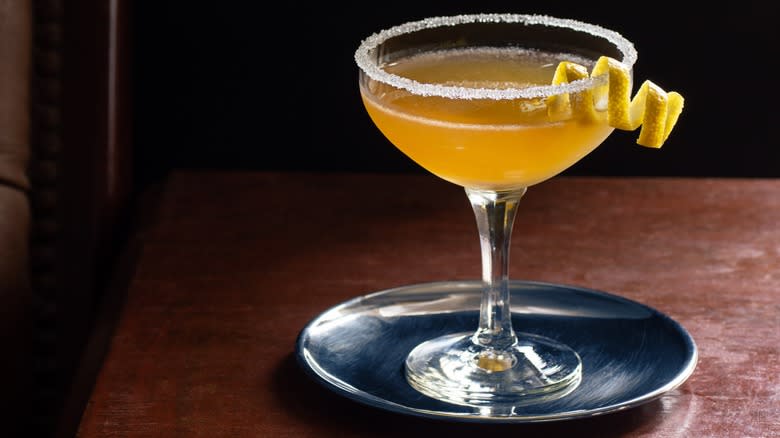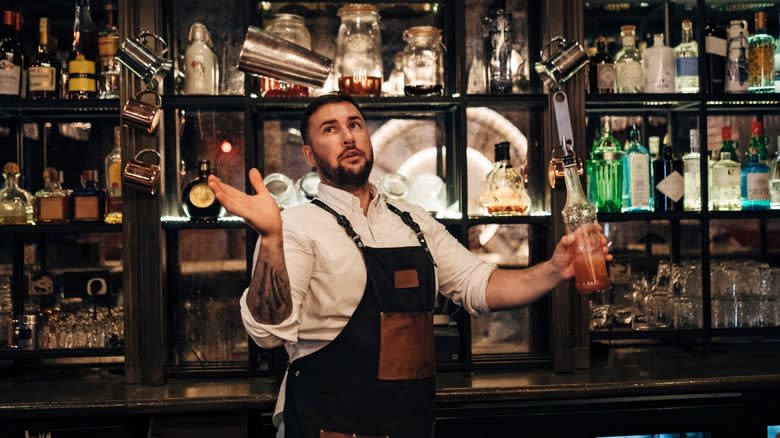A Cadillac Sidecar Is The Classic Cocktail Perfect For Citrus Lovers

The Cadillac Sidecar cocktail -- also known simply as the Sidecar -- is made from Cognac, orange liqueur, and fresh lemon juice. It's a dry, spirit-forward cocktail with nearly 3 ounces of high-proof alcohol served up in a sugar-rimmed coupe glass. If that doesn't scream "early 20th-century bar trends," what does? Nobody really knows who first invented the Cadillac Sidecar, but legend has it that it was born in the bars of Paris at the turn of the century, possibly during the First World War. It was well-documented by 1922, at the very latest.
Sipping on a Cadillac Sidecar, you get notes of sweet and sour citrus thanks to the lemon and orange. The drink balances this fruity profile with the bold-bodied Cognac, which brings a touch of sweetness from the grapes it's made from but maintains a sense of gravity similar to a port. Throw it all together and you have a fun, adventurous twist on the classic sour that's 50% citrus.
The Cadillac Sidecar is a fine-tuned evolution of the Brandy Crusta, which is commonly associated with the thriving cocktail scene of 19th-century New Orleans. The Brandy Crusta has the same base ingredients as the Cadillac Sidecar -- brandy, lemon juice, and orange liqueur -- but it uses orange curaçao instead of Cointreau and adds maraschino liqueur, superfine sugar, and a dash of Angostura bitters to the mix. Both drinks are shaken and served up, meaning without ice. It's interesting to see how the child of the Brandy Crusta took away ingredients instead of adding new ones.
Read more: 13 Liquors Your Home Bar Should Have
Understanding The Bartender's Golden Ratio

If you want to know why the Cadillac Sidecar shaved off the excesses of the Brandy Crusta, you have to understand a little bartender's theory. To make a Cadillac Sidecar, it takes 2 parts Cognac, 1 part Cointreau or other orange liqueur, and 1 part fresh lemon juice. This ratio of 2:1:1 balances the base liquor, sweetness, and sourness. It's known as the bartender's golden ratio because it underlies an enormous number of legendary cocktails, including the daiquiri, the gimlet, and the margarita.
To break the ratio down, the Sidecar's 2:1:1 calls for 2 parts base spirit, 1 part sour, and 1 part sweet. When we say "parts" we are really talking about ratios. So, if you're doing a big batch and you use 10 ounces of, say, whiskey, you would use 5 ounces of simple syrup and 5 ounces of lemon juice. Fun fact: That's exactly how you make a whiskey sour.
The Brandy Crusta is delicious all on its own, but, by taking the core essence of what the drink was trying to do and slimming it down to fit the golden ratio, the Cadillac Sidecar took a good drink and turned it into a legendary one. The golden ratio is used by bartenders all over the world, even in cocktails that don't use citrus, because it is an excellent starting point for creating a balanced drink when you're experimenting with something new. Modern cocktails may sometimes lean towards maximalism, but even those rely on a core foundation of balancing flavors.
Read the original article on Tasting Table.

